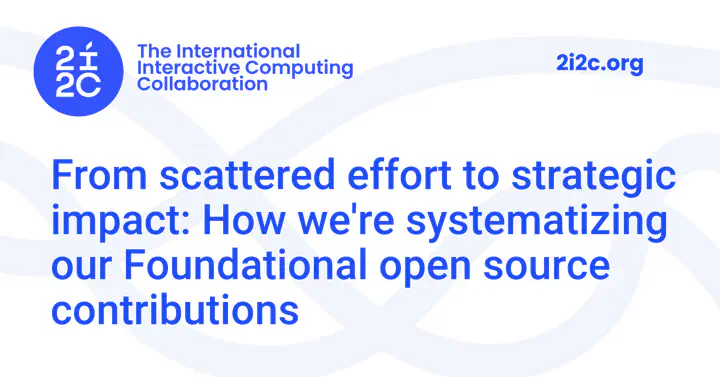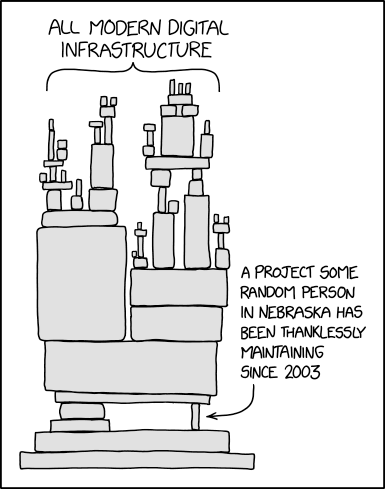From scattered effort to strategic impact: How we're systematizing our Foundational open source contributions

Over the past year we’ve experimented with being more strategic about supporting upstream communities as a team. This post summarizes our current plan, including team targets and practices we’ll continue to pilot. We’ll revisit this as we learn more.
Note: This document is about the Foundational contributions we make so that open source communities are healthier and more impactful. It is not about Directed upstream contributions we make as part of our own product work. See On being a good open source citizen: supporting a healthy ecosystem through directed and foundational contributions.
The challenge: Why scattered individual efforts aren’t enough #
Healthy open source communities rely on both individual and institutional contributions. 2i2c aims to be an excellent “upstream citizen”, so we need a structured approach with clear goals and rationale for why it’s the best use of our team’s time.
Without a coordinated approach, we risk two problematic outcomes:
Best case: Scattered, individual efforts that are subject to the Tyranny of Structurelessness. We help at the margins but not meaningfully.
Worst case: Our organizational capacity inadvertently dominates communities, making 2i2c the sole stakeholder capable of meaningful development and maintenance. We functionally take over the project.
By setting explicit goals, both our member communities and upstream projects can hold us accountable for actions that strengthen rather than undermine community health.
Our long-term goal: Multi-stakeholder, resilient communities #
With this in mind, we’ve chosen the following outcomes as our major goals for upstream contribution:
We want the Jupyter1 community to be a multi-stakeholder2, diverse3 community with a very high bus factor, because we believe this is a critical pre-requisite for advancing our mission and value proposition.
We want to build team processes that help upstream communities make progress towards this goal, so everyone can equitably participate with the support they need.
Two key objectives #
Starting with JupyterHub, we’ve identified two objectives that will guide our work:
Objective 1: Increase the number of casual but returning contributors to the JupyterHub community
Objective 2: Increase the number of total maintainers in the JupyterHub community
We’ve chosen these objectives because (1) they have impact, (2) we can make meaningful progress on them, and (3) we can integrate this work into our team’s workflow.
For each activity below, we’ve brainstormed some Key Performance Indicators (KPIs) to track progress and ensure we’re learning effectively.
Four pilot activities #
We’ll experiment with these four activities4:
- Review pull requests from non-maintainers
- Issue Triage office hours
- Sponsoring and Mentoring new Maintainers
- Increase bus factor and diversity of people making releases
Review Pull Requests from non-maintainers #
Imagine two different scenarios:
- You casually contribute a PR to some OSS project. Someone responds the next day, you have a pleasant back and forth, and it gets merged (or rejected) within a few days.
- You casually contribute a PR to some OSS project. Nobody responds for a year. Eventually someone leaves a comment. You have forgotten everything, and don’t even respond. Much later, your PR gets closed as stale.
Which experience will encourage you to come back and contribute again?
It’s clearly (1). We should use our institutional capacity to bring the community closer to (1).
We’ll accomplish this by including the following work item in every sprint:
Review of N PRs by non-maintainers of JupyterHub
We will build skills (via pairing, training, etc) inside 2i2c, as not everyone will feel comfortable reviewing pull requests for all projects, nor have rights to merge or close PRs. We may also do additional work like new contributor drives, better documentation, and policy advocacy. We will include pull requests of all types, not just code contributions.
KPIs #
We imagine two KPIs for this activity:
- Number of PRs merged (or closed) through our sprint planning activity.
- Number of returning contributors whose PRs were reviewed by us.
Issue Triage office hours #
Issue Triage involves combing through an upstream repository’s issue tracker, engaging with new issues, refining them to be actionable, and signal boosting important ones for team action. This is hard for newcomers, as it often requires deep knowledge of various components to understand how to direct an issue or refine it. It’s also challenging for team members still learning open source community dynamics. We’d like to upskill our team members within 2i2c and our upstream open source communities.
As part of our sprints, we will run regular “Issue Triage” office hours. We’ll begin by upskilling our own 2i2c team members in effective issue triaging. We’ll then explore opening issue triage sessions to the broader upstream community.
KPIs #
- Number of issues triaged by 2i2c team members.5
Sponsoring and Mentoring new Maintainers #
OSS communities must grow their contributors into maintainers, or they will die.
Growing new maintainers takes time and effort from both the potential maintainer and existing maintainers who mentor and sponsor them. The focus on sponsorship is important, as laid out by Lara Hogan. This work takes years, not months, to manifest.
We will build structures to identify potential maintainers and create pathways for them to gain maintainership status. As JupyterHub lacks an explicit maintainer pathway, we will build our own process via these focus areas:
- Identifying potential candidates for maintainership
- Identifying potential community work they can do to help get involved (contributing bug fixes, code reviewing, issue triage, helping answer questions, contributing code / documentation, release management, etc)
- Build pathways for candidates to do (2) as appropriate.
- Iteratively continue until candidates have done ’enough’ work to gain maintainership status.
This work is nebulous but worthwhile. We will coordinate this effort closely with community leaders, recognizing it takes time to actualize.
In the Jupyter community, maintainership status is tied to individuals, not to organizations they work for. Nobody should get maintainership status simply because they work for a specific organization (such as 2i2c). We should look for diverse candidates, ideally funded by different organizations, who are interested in becoming maintainers.
Note: We’d also like to start with individuals in our collaborator network. For example, we’re using an engagement between NASA VEDA and Development Seed to onboard several team members into these projects.
KPI #
This measurement moves slowly, but is very clearly impactful:
- Number of people who have become maintainers due to our concerted efforts.
Increase bus factor and diversity of people making releases #
Making releases is often thankless but important to community health. It involves coordinating testing, writing changelogs, and providing upgrade instructions. Institutions can help by dedicating team time to perform this task regularly. To advance the ‘multi-stakeholder’ and ‘high bus factor’ aspects of our goal, we will have many different people do releases, via mentorship and sponsorship. This will integrate into our regular workstreams.
KPIs #
- Number of releases performed by 2i2c engineers
- Number of releases performed by others with sponsorship / mentorship from 2i2c engineers
Criteria for upstream projects to support #
Our long-term goal applies to upstream communities that:
- We strategically depend on to serve our member communities as part of our community hub service
- We need to help sustain, given upstream community dynamics
- We have the ability to help sustain
For example, Kubernetes satisfies (1) but not (2) or (3), while JupyterLab meets (1) and (2) but not (3) (presently). Currently this policy only applies to JupyterHub, but may change as our organization evolves.
How we’ll implement this #
Who is responsible #
Implementation is the responsibility of 2i2c’s Product & Services team. These activities must integrate into the team’s daily practices, not become an external shadow process for some members.
How we’ll fund this work #
Foundational upstream support requires significant work and expertise. We plan to fund this through:
- Fees from our member communities. A percentage of our membership fees includes covering the cost of Foundational contributions like this.
- Targeted contributions from some of our collaborators. Some collaborators have funds and want to support open source at a foundational level, in some cases we use funds from these collaborators to cover our costs.
We still need to explore what these efforts cost and mechanisms to recover those costs.
Next step: Learning in public #
We’re excited to experiment with more effective upstream contribution and eager to learn. We’ll share our experiences so others can learn from and comment on our process.
Acknowledgements #
- @MinRK and - @bsipocz for helping review a draft of this!
- @choldgraf for feedback, guidance, and editing for this post and the team practices in it.
- JupyterHub, JupyterBook, and Project Jupyter for teaching us a lot about open source over the years.
Currently this is particularly JupyterHub and Jupyter-wide leadership. We’re exploring how to incorporate JupyterBook into our service and are thus investing Foundation contributions there as well. ↩︎
With different kinds and sizes of organizations (companies, non-profits, universities, etc) and individuals being stakeholders. We want to avoid a single organization monopolizing power within any community. ↩︎
Across the power spectrum - from users to bug reporters to casual contributors to maintainers to people on governance duty ↩︎
Implementation note: We will not start doing all these immediately! We will consult with the rest of the team, and start these 1 at a time so we can build these processes sustainably and equitably. ↩︎
This requires a definition of “an issue that has been triaged”, and to our knowledge no such definition exists. We’d like to learn how to measure something abstract like “issue triage” - perhaps it is something specific putting it on a board for further action or applying a label, or something more abstract like “increasing how clear and actionable the issue is”. We’ll explore this when we start to make progress towards this objective. ↩︎
Thanks for reading! If you'd like to follow our work, join our mailing list or subscribe to our blog. You can read our community hub documentation or learn about membership.
